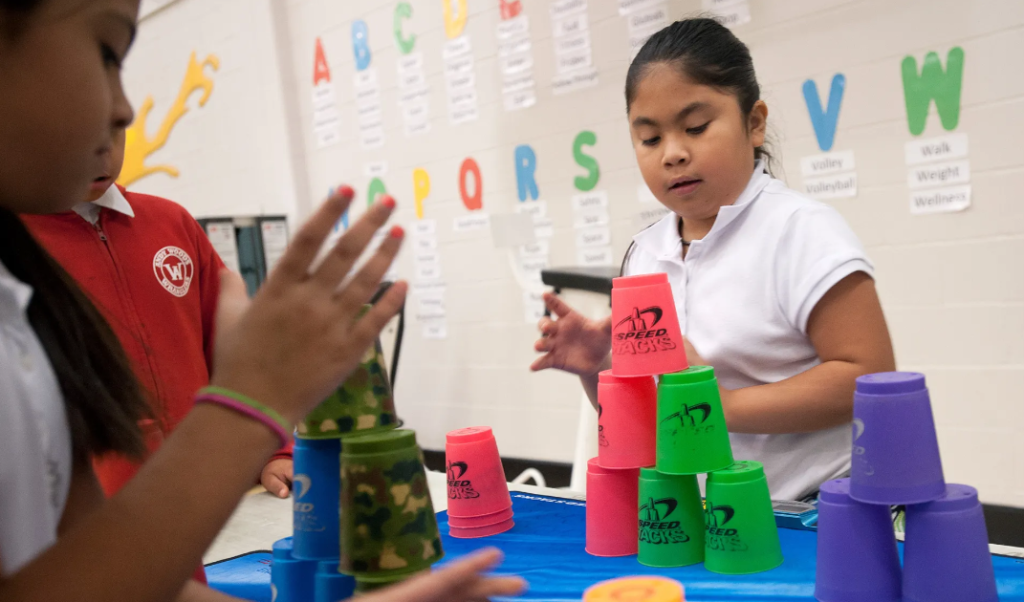As second grade teachers, we know that our students are exploring new relationships, changing social dynamics, and feeling the emotional burdens these interactions can bring. Our students often encounter conflict as we ask them to take risks, stand up for their beliefs, and share their thoughts and opinions. With this in mind, we created and piloted a three-pronged hands-on approach to build comfort and skills around managing conflict.
Our approach includes collaborative games and design challenges, as well as the proverbial question jar. Each component is designed to allow our students to encounter ongoing developmentally appropriate and different types of conflict to build problem-solving skills. In each activity, students are placed in a wide variety of mixed groups where they are faced with increasingly complex challenges, last-minute changes, and peer-leadership opportunities that change social dynamics. We are excited to share our approach and help other teachers implement these ideas.
The first few weeks of the year are all about community building, developing practices, and getting to know our students better as people and learners. Cooperative games are a great way to help students build relationships and begin to work together as a team. When we thought carefully about our starting point, we knew we wanted to focus on cooperative games that were easy to prepare, low cost, easy to introduce, and quick to experience. We wanted students to practice thinking flexibly, switching roles, and collectively discovering successes and failures.
Some of our favorite games are the Balloon Challenge, the Color Dot Game, and the Airplane Game. While we introduced many of these games in the first semester, we revisited more complex versions, adjusted group sizes, and over time pushed students to become more independent through challenges.
Having had some experience designing challenges in the past, we knew we could use them to push students in unique ways, and these activities are often excellent breeding grounds for conflict. We also like that they provide an opportunity for students to work in small, fluid groups and complete challenges together using different low-cost and common materials.

Starting Point
First, students were introduced to the challenge and had five minutes of brainstorming time in which they worked as a group to develop a plan. After five minutes, students picked up their materials and began creating for 10 to 20 minutes, depending on the challenge. There is never a winner that is celebrated or recognized; instead, we applaud the students for working together. Once the timer runs out, students reflect on the process through group discussions and independently as part of an exit ticket.
Examples of design challenges that our students enjoy are the cup stacking, the Pepto and toothpick building challenge, and the egg drop challenge. We have found that assigning leadership roles in groups and increasing the level of difficulty both motivate students to overcome new challenges and discomfort. Feel free to be inspired by these activities, but change them as you see fit.
Assessment
We know that effective assessment tools help drive instruction and build our understanding of our students’ feelings and needs. To that end, we have created multiple types of formal and informal assessments that can be completed quickly and easily to help maintain consistency and encourage our students to reflect on themselves as problem solvers.
Our students fill out a bounced check based on a Likert scale, which allows us to track how their understanding of conflict has changed over time after engaging in collaborative games and design challenges.
Checking in
At the end, we know that students love their teachers, seek their approval, and enjoy sharing what is happening in their own lives. The “Best Friend Jar” and “Question Jar” provide a space where students can examine their emotional experiences, identities, and cultures, and use their real-life questions to share their thoughts and help them overcome verbalizing uncomfortable and tricky feelings.
Both jars were open to students during the week. Students contributed anonymously to the jars and were encouraged to submit one “known goodie” or one question per student during the week. On Fridays, we read through the problem jars as a class, discussing possible solutions or just acknowledging that some of the problems can’t be solved right away, but that by discussing them, we’re communicating, and we’re going to work harder to figure out a plan.
Giving students the space to see that we, as their teachers, take their ideas and opinions seriously, and then connecting their problems to practical, immediate action is important to encourage students to become problem solvers. We also ask students to think about how they naturally handle and respond to conflict. Providing them with this opportunity for self-reflection allows them to recognize their own strengths and challenges. The more we know about each other, the more openly we can share our feelings and engage in productive conflict.
